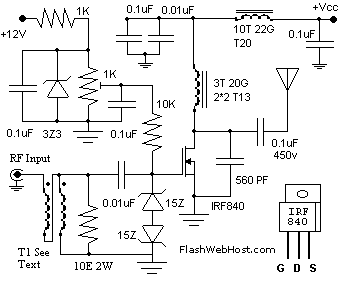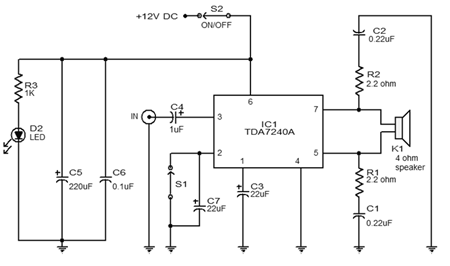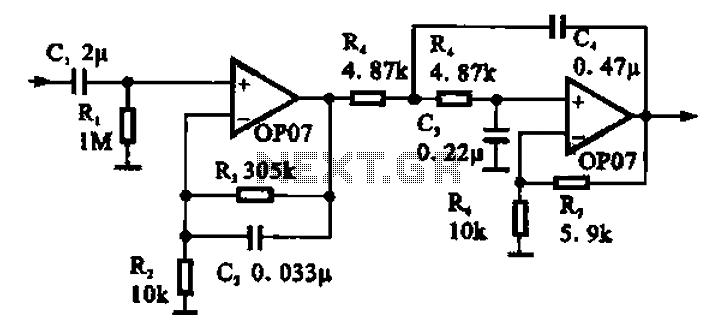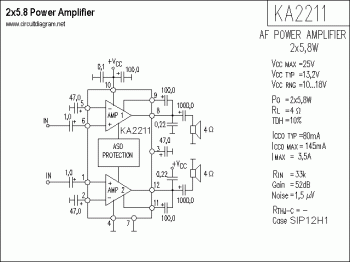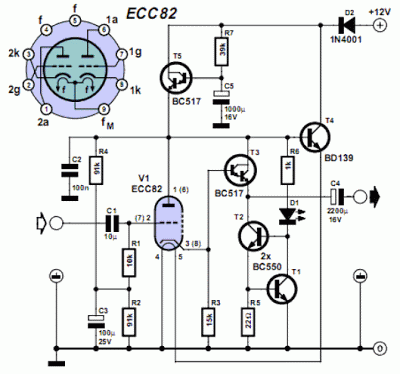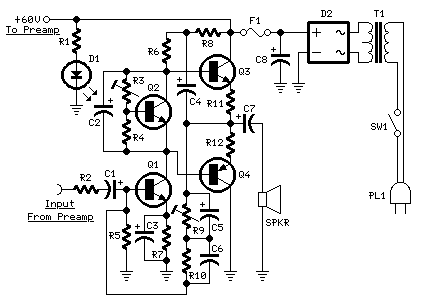
Crossfeed Headphone Amplifier
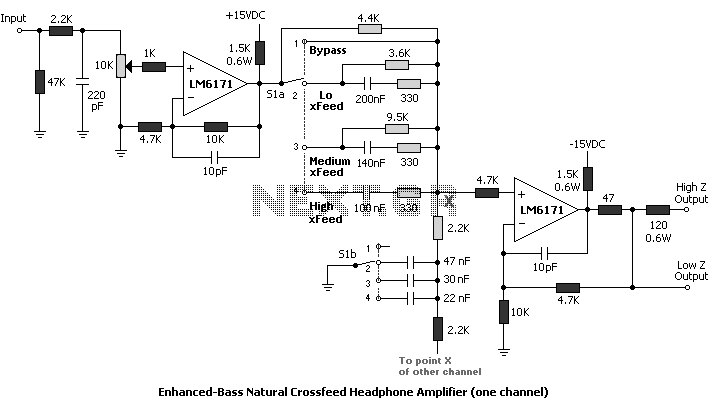
Building a headphone amplifier is like building a power amp - only the current demand is just a little bit lower (about a factor 100). Various designs can be found in the internet, and it is relatively easy to integrate the proposed crossfeed filter. I designed my own which is op-amp based. I know, many hi-fi enthusiasts say "yuck" to opamps, but note that even in many so-called "High-End" CD-players, opamps are found in the signal path for amplification and filtering. The op-amps should be chosen with care. They have to be able to deliver relatively high current values and to drive low impedance loads. I decided to use the National Semiconductor LM6171. This is a wide band (100 MHz) voltage-feedback opamp that is able to deliver 10V into a 100 ohm load. To prevent difficulties when driving low-impedance headphones (32 ohms or less), I placed a 47 ohm resistor at the output of each channel. With my Beyerdynamics (DT990/DT931, 600/250 ohm) and my Sennheiser (HD600, 300 ohm) headphones, the opamps perform most adequately. Other alternatives are the LM6172/6181/6182, the OPA604/627 by Burr-Brown (used in the HeadRoom systems) or the LTC1206/1207 by Linear Technology (able to drive 30 ohm loads!). The schematics shown in figures 6a/6b/6c represent the third generation of my original design. There are two versions of the headphone amplifier: one with the standard crossfeed and one with the enhanced bass crossfeed. The standard crossfeed sound is nothing for a bass-freak. One should not expect a punchy bass, only a relaxation of the sound.
The two crossfeed settings of the original bass-enhanced filter are comparable to the low and the high crossfeed levels of the standard filter in this article. The enhanced-bass filter has a frequency response very similar to the modified Linkwitz filter to compensate for any apparent loss of bass due to the crossfeed. While I hardly notice any specific loss of bass with the standard filter, I present the enhanced-bass design to give DIYers an option of which filter to build. I have added a medium crossfeed level so that both the standard and bass-enhanced filters now have 4 settings. The 4.4K resistor bridges the switch at all settings to reduce any "blops" during switching. A stable power supply to the opamps is crucial for optimal performance. I used a toroid transformer. Charge-reservoirs of 1000uF and two voltage regulators (L7815/7915) provide constant voltages of ±15VDC. Moreover, high frequency noise is extensively filtered by 100mH inductors. 2200uF capacitors and 100nF film capacitors further reduce any ripple and noise after the voltage regulators.
The amplification and power supply circuitry is rather straightforward. Both the standard and enhanced-bass filters have four crossfeed level settings: none (normal stereo mode), low, medium, and high. No opamp is perfect. To ensure a zero offset voltage at the output, the impedance values in the circuitry have been carefully balanced. Do not use other resistor values than as indicated in the schematics, as this might lead to damage of your headphones.
The headamp has two sockets for connection to headphones. Both sockets will provide different sound characteristics. One socket has a very low output impedance and gives the amp tight control over the headphone action. However, many headphones have been sonically optimized to be driven by an output impedance of 120 Ohms and may sound better when connected to the other socket. Generally, the low impedance socket provides a clean sound whereas the high impedance socket yields a warmer sound. Use the one preferred. There is no risk of damage to headphones by connecting them to either socket. The output stage of each opamp is connected to one of the voltage rails by a 1.5 kOhm resistor. This forces the output stage into class-A functionality and increases sound quality considerably. Also, 10pF capacitors are added to the feedback loop to increase stability at high frequencies. Careful matching of all resistors prevents offset voltages and the need for coupling capacitors, and the amplifier is now DC-coupled. The power supply has a ground loop breaker, so the audio inputs and outputs must have floating grounds; their grounds cannot be directly connected to the enclosure.Building a headphone amplifier is like building a power amp - only the current demand is just a little bit lower (about a factor 100). Various designs can be found in the internet, and it is relatively easy to integrate the proposed crossfeed filter.
I designed my own (see the picture) which is op-amp based. I know, many hi-fi enthusiasts say "yuck" to opamps, but note that even in many so-called "High-End" CD-players, opamps are found in the signal path for amplification and filtering. The op-amps should be chosen with care. They have to be able to deliver relatively high current values and to drive low impedance loads. I decided to use the National Semiconductor LM6171. This is a wide band (100 MHz) voltage-feedback opamp that is able to deliver 10V into a 100 ohm load. To prevent difficulties when driving low-impedance headphones (32 ohms or less), I placed a 47 ohm resistor at the output of each channel.
With my Beyerdynamics (DT990/DT931, 600/250 ohm) and my Sennheiser (HD600, 300 ohm) headphones, the opamps perform most adequately. Other alternatives are the LM6172/6181/6182, the OPA604/627 by Burr-Brown (used in the HeadRoom systems) or the LTC1206/1207 by Linear Technology (able to drive 30 ohm loads!).
The schematics shown in figures 6a/6b/6c represent the third generation of my original design. There are two versions of the headphone amplifier: one with the standard crossfeed and one with the enhanced bass crossfeed (see An Enhanced-Bass Natural Crossfeed Filter for more information). The standard crossfeed sound is nothing for a bass-freak. One should not expect a punchy bass, only a relaxation of the sound. The two crossfeed settings of the original bass-enhanced filter are comparable to the low and the high crossfeed levels of the standard filter in this article.
The enhanced-bass filter has a frequency response very similar to the modified Linkwitz filter to compensate for any apparent loss of bass due to the crossfeed. While I hardly notice any specific loss of bass with the standard filter, I present the enhanced-bass design to give DIYers an option of which filter to build.
I have added a medium crossfeed level so that both the standard and bass-enhanced filters now have 4 settings. The 4.4K resistor bridges the switch at all settings to reduce any "blops" during switching. A stable power supply to the opamps is crucial for optimal performance (figure 6c). I used a toroid transformer. Charge-reservoirs of 1000uF and two voltage regulators (L7815/7915) provide constant voltages of ±15VDC.
Moreover, high frequency noise is extensively filtered by 100mH inductors. 2200uF capacitors and 100nF film capacitors further reduce any ripple and noise after the voltage regulators. I admit that the large capacitors are a little bit overdone. When I switch the device off it will still work for about 10 seconds. However, capacitors are relatively cheap, so why not. The amplification and power supply circuitry is rather straightforward. I have just a few notes: Both the standard and enhanced-bass filters have four crossfeed level settings: none (normal stereo mode), low, medium and high.
I personally prefer the low and the medium crossfeed levels for most applications. No opamp is perfect. To ensure a zero offset voltage at the output the impedance values in the circuitry have been carefully balanced. Do not use other resistor values than as indicated in the schematics, as this might lead to damage of your headphones.
The headamp has two sockets for connection to headphones. Both sockets will provide different sound characteristics. One socket has a very low output impedance and gives the amp tight control over the headphone action. However, many headphones have been sonically optimized to be driven by an output impedance of 120 Ohms and may sound better when connected to the other socket.
Generally, the low impedance socket provides a clean sound whereas the high impedance socket yields a warmer sound. Use the one you like most. There is no risk of damage to your headphone by connecting it to either socket. You can also use the sockets to connect two headphones simultaneously. However, the volume produced by the high impedance socket will be slightly lower than that of the other socket.
The output stage of each opamp is connected to one of the voltage rails by a 1.5 kOhm resistor. This forces the output stage into class-A functionality and increases soundquality considerably. Also 10pF capacitors are added to the feedback loop to increase stability at high frequencies. Careful matching of all resistors prevents offset voltages and the need of coupling capacitors and the amplifier now is DC-coupled. The power supply has a ground loop breaker, so the audio inputs and outputs MUST have floating grounds - their grounds cannot be directly connected to the enclosure.
(See A Precision Preamplifier-Power Amplifier System with Natural Crossfeed Processing for more discussion about biasing opamps to function in class A and ground-breakers in power supplies). 🔗 External reference
The two crossfeed settings of the original bass-enhanced filter are comparable to the low and the high crossfeed levels of the standard filter in this article. The enhanced-bass filter has a frequency response very similar to the modified Linkwitz filter to compensate for any apparent loss of bass due to the crossfeed. While I hardly notice any specific loss of bass with the standard filter, I present the enhanced-bass design to give DIYers an option of which filter to build. I have added a medium crossfeed level so that both the standard and bass-enhanced filters now have 4 settings. The 4.4K resistor bridges the switch at all settings to reduce any "blops" during switching. A stable power supply to the opamps is crucial for optimal performance. I used a toroid transformer. Charge-reservoirs of 1000uF and two voltage regulators (L7815/7915) provide constant voltages of ±15VDC. Moreover, high frequency noise is extensively filtered by 100mH inductors. 2200uF capacitors and 100nF film capacitors further reduce any ripple and noise after the voltage regulators.
The amplification and power supply circuitry is rather straightforward. Both the standard and enhanced-bass filters have four crossfeed level settings: none (normal stereo mode), low, medium, and high. No opamp is perfect. To ensure a zero offset voltage at the output, the impedance values in the circuitry have been carefully balanced. Do not use other resistor values than as indicated in the schematics, as this might lead to damage of your headphones.
The headamp has two sockets for connection to headphones. Both sockets will provide different sound characteristics. One socket has a very low output impedance and gives the amp tight control over the headphone action. However, many headphones have been sonically optimized to be driven by an output impedance of 120 Ohms and may sound better when connected to the other socket. Generally, the low impedance socket provides a clean sound whereas the high impedance socket yields a warmer sound. Use the one preferred. There is no risk of damage to headphones by connecting them to either socket. The output stage of each opamp is connected to one of the voltage rails by a 1.5 kOhm resistor. This forces the output stage into class-A functionality and increases sound quality considerably. Also, 10pF capacitors are added to the feedback loop to increase stability at high frequencies. Careful matching of all resistors prevents offset voltages and the need for coupling capacitors, and the amplifier is now DC-coupled. The power supply has a ground loop breaker, so the audio inputs and outputs must have floating grounds; their grounds cannot be directly connected to the enclosure.Building a headphone amplifier is like building a power amp - only the current demand is just a little bit lower (about a factor 100). Various designs can be found in the internet, and it is relatively easy to integrate the proposed crossfeed filter.
I designed my own (see the picture) which is op-amp based. I know, many hi-fi enthusiasts say "yuck" to opamps, but note that even in many so-called "High-End" CD-players, opamps are found in the signal path for amplification and filtering. The op-amps should be chosen with care. They have to be able to deliver relatively high current values and to drive low impedance loads. I decided to use the National Semiconductor LM6171. This is a wide band (100 MHz) voltage-feedback opamp that is able to deliver 10V into a 100 ohm load. To prevent difficulties when driving low-impedance headphones (32 ohms or less), I placed a 47 ohm resistor at the output of each channel.
With my Beyerdynamics (DT990/DT931, 600/250 ohm) and my Sennheiser (HD600, 300 ohm) headphones, the opamps perform most adequately. Other alternatives are the LM6172/6181/6182, the OPA604/627 by Burr-Brown (used in the HeadRoom systems) or the LTC1206/1207 by Linear Technology (able to drive 30 ohm loads!).
The schematics shown in figures 6a/6b/6c represent the third generation of my original design. There are two versions of the headphone amplifier: one with the standard crossfeed and one with the enhanced bass crossfeed (see An Enhanced-Bass Natural Crossfeed Filter for more information). The standard crossfeed sound is nothing for a bass-freak. One should not expect a punchy bass, only a relaxation of the sound. The two crossfeed settings of the original bass-enhanced filter are comparable to the low and the high crossfeed levels of the standard filter in this article.
The enhanced-bass filter has a frequency response very similar to the modified Linkwitz filter to compensate for any apparent loss of bass due to the crossfeed. While I hardly notice any specific loss of bass with the standard filter, I present the enhanced-bass design to give DIYers an option of which filter to build.
I have added a medium crossfeed level so that both the standard and bass-enhanced filters now have 4 settings. The 4.4K resistor bridges the switch at all settings to reduce any "blops" during switching. A stable power supply to the opamps is crucial for optimal performance (figure 6c). I used a toroid transformer. Charge-reservoirs of 1000uF and two voltage regulators (L7815/7915) provide constant voltages of ±15VDC.
Moreover, high frequency noise is extensively filtered by 100mH inductors. 2200uF capacitors and 100nF film capacitors further reduce any ripple and noise after the voltage regulators. I admit that the large capacitors are a little bit overdone. When I switch the device off it will still work for about 10 seconds. However, capacitors are relatively cheap, so why not. The amplification and power supply circuitry is rather straightforward. I have just a few notes: Both the standard and enhanced-bass filters have four crossfeed level settings: none (normal stereo mode), low, medium and high.
I personally prefer the low and the medium crossfeed levels for most applications. No opamp is perfect. To ensure a zero offset voltage at the output the impedance values in the circuitry have been carefully balanced. Do not use other resistor values than as indicated in the schematics, as this might lead to damage of your headphones.
The headamp has two sockets for connection to headphones. Both sockets will provide different sound characteristics. One socket has a very low output impedance and gives the amp tight control over the headphone action. However, many headphones have been sonically optimized to be driven by an output impedance of 120 Ohms and may sound better when connected to the other socket.
Generally, the low impedance socket provides a clean sound whereas the high impedance socket yields a warmer sound. Use the one you like most. There is no risk of damage to your headphone by connecting it to either socket. You can also use the sockets to connect two headphones simultaneously. However, the volume produced by the high impedance socket will be slightly lower than that of the other socket.
The output stage of each opamp is connected to one of the voltage rails by a 1.5 kOhm resistor. This forces the output stage into class-A functionality and increases soundquality considerably. Also 10pF capacitors are added to the feedback loop to increase stability at high frequencies. Careful matching of all resistors prevents offset voltages and the need of coupling capacitors and the amplifier now is DC-coupled. The power supply has a ground loop breaker, so the audio inputs and outputs MUST have floating grounds - their grounds cannot be directly connected to the enclosure.
(See A Precision Preamplifier-Power Amplifier System with Natural Crossfeed Processing for more discussion about biasing opamps to function in class A and ground-breakers in power supplies). 🔗 External reference
